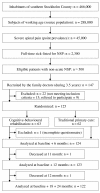Predictors of stable return-to-work in non-acute, non-specific spinal pain: low total prior sick-listing, high self prediction and young age. A two-year prospective cohort study
- PMID: 20646286
- PMCID: PMC2919451
- DOI: 10.1186/1471-2296-11-53
Predictors of stable return-to-work in non-acute, non-specific spinal pain: low total prior sick-listing, high self prediction and young age. A two-year prospective cohort study
Abstract
Background: Non-specific spinal pain (NSP), comprising back and/or neck pain, is one of the leading disorders in long-term sick-listing. During 2000-2004, 125 Swedish primary-care patients with non-acute NSP, full-time sick-listed 6 weeks-2 years, were included in a randomized controlled trial to compare a cognitive-behavioural programme with traditional primary care. This prospective cohort study is a re-assessment of the data from the randomized trial with the 2 treatment groups considered as a single cohort. The aim was to investigate which baseline variables predict a stable return-to-work during a 2-year period after baseline: objective variables from function tests, socioeconomic, subjective and/or treatment variables. Stable return-to-work was a return-to-work lasting for at least 1 month from the start of follow-up.
Methods: Stable return-to-work was the outcome variable, the above-mentioned factors were the predictive variables in multiple-logistic regression models, one per follow-up at 6, 12, 18 and 24 months after baseline. The factors from univariate analyzes with a p-value of at most .10 were included. The non-significant variables were excluded stepwise to yield models comprising only significant factors (p < .05). As the comparatively few cases made it risky to associate certain predictors with certain time-points, we finally considered the predictors which were represented in at least 3 follow-ups. They are presented with odds ratios (OR) and 95% confidence intervals.
Results: Three variables qualified, all of them represented in 3 follow-ups: Low total prior sick-listing (including all diagnoses) was the strongest predictor in 2 follow-ups, 18 and 24 months, OR 4.8 [1.9-12.3] and 3.8 [1.6-8.7] respectively, High self prediction (the patients' own belief in return-to-work) was the strongest at 12 months, OR 5.2 [1.5-17.5] and Young age (max 44 years) the second strongest at 18 months, OR 3.5 [1.3-9.1].
Conclusions: In primary-care patients with non-acute NSP, the strong predictors of stable return-to-work were 2 socioeconomic variables, Low total prior sick-listing and Young age, and 1 subjective variable, High self-prediction. Objective variables from function tests and treatment variables were non-predictors. Except for Young age, the predictors have previously been insufficiently studied, and so our study should widen knowledge within clinical practice.
Trial registration: ClinicalTrials.gov NCT00488735.
Figures
Similar articles
-
Subacute and chronic, non-specific back and neck pain: cognitive-behavioural rehabilitation versus primary care. A randomized controlled trial.BMC Musculoskelet Disord. 2008 Dec 30;9:172. doi: 10.1186/1471-2474-9-172. BMC Musculoskelet Disord. 2008. PMID: 19116007 Free PMC article. Clinical Trial.
-
Predictors of return to work among women with long-term neck/shoulder and/or back pain: A 1-year prospective study.PLoS One. 2021 Nov 23;16(11):e0260490. doi: 10.1371/journal.pone.0260490. eCollection 2021. PLoS One. 2021. PMID: 34813601 Free PMC article.
-
Can the STarT Back Tool predict health-related quality of life and work ability after an acute/subacute episode with back or neck pain? A psychometric validation study in primary care.BMJ Open. 2018 Dec 22;8(12):e021748. doi: 10.1136/bmjopen-2018-021748. BMJ Open. 2018. PMID: 30580256 Free PMC article.
-
Primary care consultation, hospital admission, sick leave and disability pension owing to neck and low back pain: a 12-year prospective cohort study in a rural population.BMC Musculoskelet Disord. 2006 Aug 14;7:66. doi: 10.1186/1471-2474-7-66. BMC Musculoskelet Disord. 2006. PMID: 16907991 Free PMC article.
-
Why and how back pain interventions work: what can we do to find out?Best Pract Res Clin Rheumatol. 2013 Oct;27(5):685-97. doi: 10.1016/j.berh.2013.10.001. Epub 2013 Oct 7. Best Pract Res Clin Rheumatol. 2013. PMID: 24315149 Review.
Cited by
-
Prediction of 2-year work participation in sickness absentees with neck or shoulder pain: the contribution of demographic, patient-reported, clinical and imaging information.BMC Musculoskelet Disord. 2019 Nov 9;20(1):525. doi: 10.1186/s12891-019-2906-4. BMC Musculoskelet Disord. 2019. PMID: 31706350 Free PMC article.
-
Development of Prediction Models for Sick Leave Due to Musculoskeletal Disorders.J Occup Rehabil. 2019 Sep;29(3):617-624. doi: 10.1007/s10926-018-09825-y. J Occup Rehabil. 2019. PMID: 30607694
-
Early workplace dialogue in physiotherapy practice improved work ability at 1-year follow-up-WorkUp, a randomised controlled trial in primary care.Pain. 2018 Aug;159(8):1456-1464. doi: 10.1097/j.pain.0000000000001216. Pain. 2018. PMID: 29554017 Free PMC article. Clinical Trial.
-
Choosing the right rehabilitation setting after herniated disc surgery: Motives, motivations and expectations from the patients' perspective.PLoS One. 2017 Aug 22;12(8):e0183698. doi: 10.1371/journal.pone.0183698. eCollection 2017. PLoS One. 2017. PMID: 28829828 Free PMC article.
-
Predictive factors for successful clinical outcome 1 year after an intensive combined physical and psychological programme for chronic low back pain.Eur Spine J. 2014 Jan;23(1):102-12. doi: 10.1007/s00586-013-2844-z. Epub 2013 Jun 16. Eur Spine J. 2014. PMID: 23771553 Free PMC article.
References
-
- Hansson T, Jensen I. In: Sickness absence - causes, consequences, and physicians' sickness-certification practice. Suppl 63. Alexanderson K, Norlund A, editor. Vol. 32. Scand J Public Health; 2004. Sickness absence due to back and neck disorders; pp. 109–151. - PubMed
-
- [Swedish; Nybeviljade sjukersättningar/aktivitetsersättningar. Fördelning på län och diagnos, 2006] Vol. 7. Social Insurance in Sweden. Statistics; 2007. Newly awarded disability pensions. Distribution between counties and diagnoses, 2006.http://statistik.forsakringskassan.se/rfvexcel/statpub/Statistik_2007-02... [In Swedish; Försäkringskassan. Statistik 2007:7]
-
- Sickness, Disability and Work. Keeping on track in the economic downturn. OECD, Directorate for employment, labour and social affairs, Background paper: High-Level Forum, Stockholm; 2009. Key trends and outcomes.http://www.oecd.org/dataoecd/42/15/42699911.pdf
-
- Waddell G, van Tulder M. In: Back Pain Revolution. 2. Waddell G, editor. Edinburgh: Churchill Livingstone; 2004. Clinical guidelines; pp. 283–322.
-
- Dionne CE, Bourbonnais R, Frémont P, Rossignol M, Stock SR, Nouwen A, Larocque I, Demers E. Determinants of "return to work in good health" among workers with back pain who consult in primary care settings: a 2-year prospective study. Eur Spine J. 2007;16:641–655. doi: 10.1007/s00586-006-0180-2. - DOI - PMC - PubMed
Publication types
MeSH terms
Associated data
LinkOut - more resources
Full Text Sources
Medical
Research Materials


